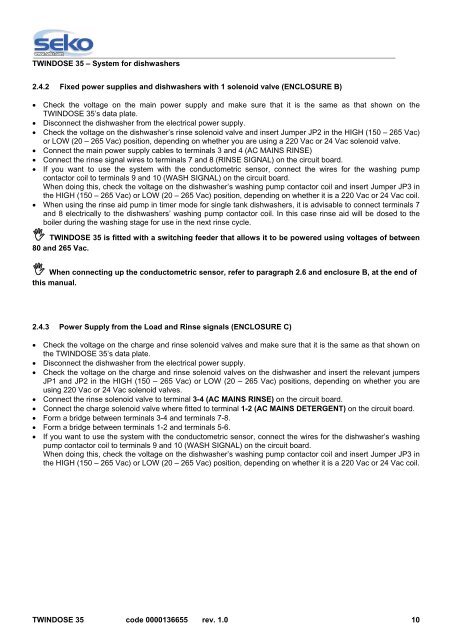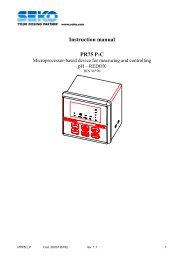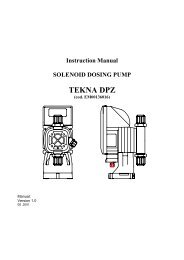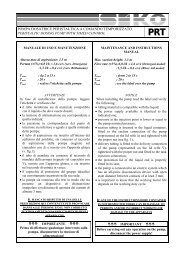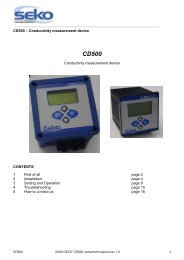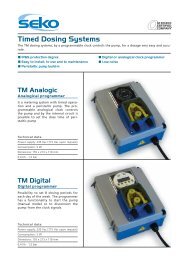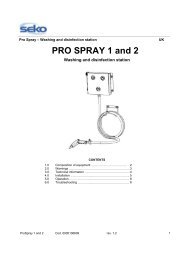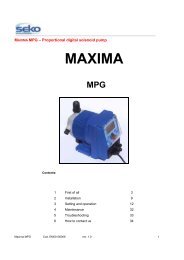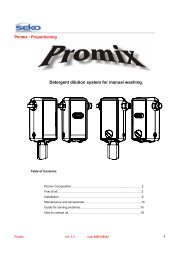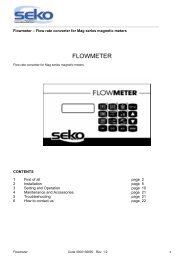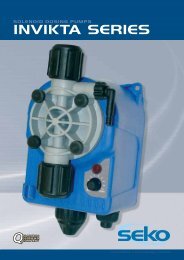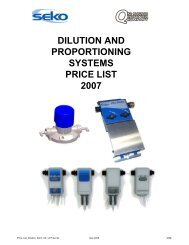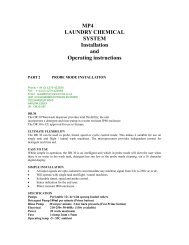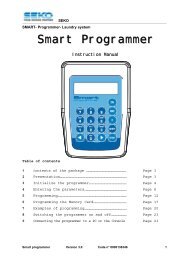Seko Twindose 35 Series Inst.. - UK
Seko Twindose 35 Series Inst.. - UK
Seko Twindose 35 Series Inst.. - UK
You also want an ePaper? Increase the reach of your titles
YUMPU automatically turns print PDFs into web optimized ePapers that Google loves.
TWINDOSE <strong>35</strong> – System for dishwashers<br />
2.4.2 Fixed power supplies and dishwashers with 1 solenoid valve (ENCLOSURE B)<br />
• Check the voltage on the main power supply and make sure that it is the same as that shown on the<br />
TWINDOSE <strong>35</strong>’s data plate.<br />
• Disconnect the dishwasher from the electrical power supply.<br />
• Check the voltage on the dishwasher’s rinse solenoid valve and insert Jumper JP2 in the HIGH (150 – 265 Vac)<br />
or LOW (20 – 265 Vac) position, depending on whether you are using a 220 Vac or 24 Vac solenoid valve.<br />
• Connect the main power supply cables to terminals 3 and 4 (AC MAINS RINSE)<br />
• Connect the rinse signal wires to terminals 7 and 8 (RINSE SIGNAL) on the circuit board.<br />
• If you want to use the system with the conductometric sensor, connect the wires for the washing pump<br />
contactor coil to terminals 9 and 10 (WASH SIGNAL) on the circuit board.<br />
When doing this, check the voltage on the dishwasher’s washing pump contactor coil and insert Jumper JP3 in<br />
the HIGH (150 – 265 Vac) or LOW (20 – 265 Vac) position, depending on whether it is a 220 Vac or 24 Vac coil.<br />
• When using the rinse aid pump in timer mode for single tank dishwashers, it is advisable to connect terminals 7<br />
and 8 electrically to the dishwashers’ washing pump contactor coil. In this case rinse aid will be dosed to the<br />
boiler during the washing stage for use in the next rinse cycle.<br />
TWINDOSE <strong>35</strong> is fitted with a switching feeder that allows it to be powered using voltages of between<br />
80 and 265 Vac.<br />
When connecting up the conductometric sensor, refer to paragraph 2.6 and enclosure B, at the end of<br />
this manual.<br />
2.4.3 Power Supply from the Load and Rinse signals (ENCLOSURE C)<br />
• Check the voltage on the charge and rinse solenoid valves and make sure that it is the same as that shown on<br />
the TWINDOSE <strong>35</strong>’s data plate.<br />
• Disconnect the dishwasher from the electrical power supply.<br />
• Check the voltage on the charge and rinse solenoid valves on the dishwasher and insert the relevant jumpers<br />
JP1 and JP2 in the HIGH (150 – 265 Vac) or LOW (20 – 265 Vac) positions, depending on whether you are<br />
using 220 Vac or 24 Vac solenoid valves.<br />
• Connect the rinse solenoid valve to terminal 3-4 (AC MAINS RINSE) on the circuit board.<br />
• Connect the charge solenoid valve where fitted to terminal 1-2 (AC MAINS DETERGENT) on the circuit board.<br />
• Form a bridge between terminals 3-4 and terminals 7-8.<br />
• Form a bridge between terminals 1-2 and terminals 5-6.<br />
• If you want to use the system with the conductometric sensor, connect the wires for the dishwasher’s washing<br />
pump contactor coil to terminals 9 and 10 (WASH SIGNAL) on the circuit board.<br />
When doing this, check the voltage on the dishwasher’s washing pump contactor coil and insert Jumper JP3 in<br />
the HIGH (150 – 265 Vac) or LOW (20 – 265 Vac) position, depending on whether it is a 220 Vac or 24 Vac coil.<br />
TWINDOSE <strong>35</strong> code 0000136655 rev. 1.0 10


